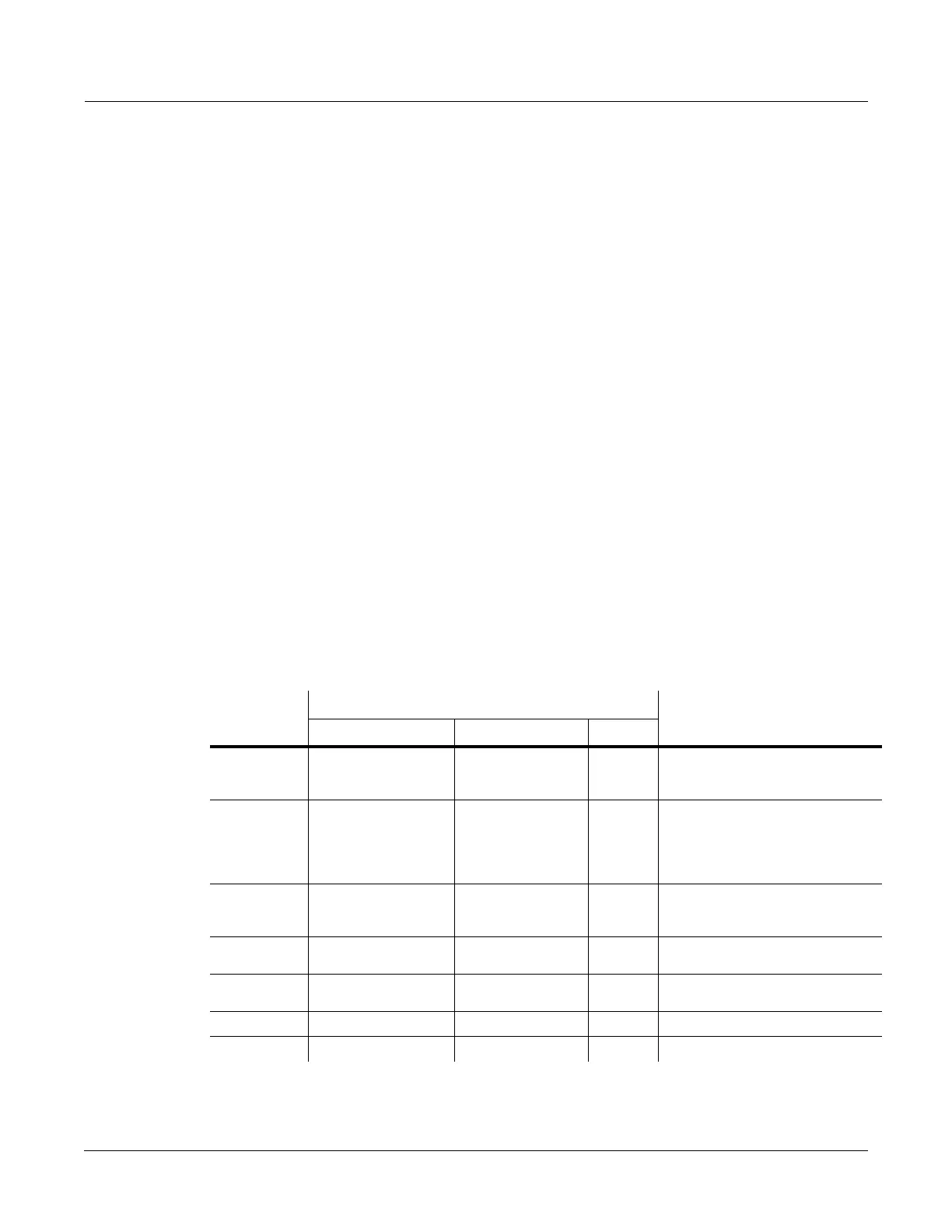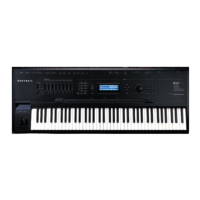Setup Mode
The ARPEGGIATOR & ARPEGGIATOR 2 (ARP1, ARP2) Pages
3-9
Shift Amount
YoucantelltheArpeggiatortotransposeallofthecurrentlylatchednoteseachtimeitplays
throughthem.Shiftdetermineshowmuchtranspositionwilloccurforeachcycleofnotes.For
example,ifyouhavelatchedC4andF4,andyouassignaNoteShiftof2,theArpeggiator
will
playC4,F4,D4,G4,E4,A4,andsoonuntilitreachestheLimitvalue.TheShiftvaluescanrange
from‐88to88,with0(thedefault)beingnotransposition.
Shift Limit
LimitdetermineshowfarupordowntheArpeggiatorshiftsfromtheoriginalnote.The
minimumvalue
is0,andthemaximumis60.WhentheArpeggiatorreachesthelimit,the
ArpeggiatorrespondsaccordingtothesettingfortheLimitOptionparameter.
Limit Option
Thisparameterdetermineswhat theArpeggiatordoeswhenithasshiftedthecurrentlylatched
notesup(ordown)totheshiftlimit.Stopcauses
theArpeggiatortostopwhenitreachesthe
shiftlimit.ResetcausestheArpeggiatortoreturntoitsoriginalpitchandrepeatthelatched
cycleofnotes,transposingeachcycleaccordingtothesettingsforNoteShiftandShiftLimit.If
thelimitallowsthenotestogooutofMIDI
range(forexample,ifyousetShiftto12,setthelimit
to60,andplayC6),thenthose“ghost”notesdon’tsound,buttheytakeuprhythmicspace:the
Arpeggiatorwaitsforthecycletoplayitselfoutbeforestartingover.
Unipolarmeansthatafterplayinguptothe
shiftlimit,theArpeggiatorbeginsshiftingnotesin
theoppositedirection,untilitreachestheoriginalpitch,whereitreversesagain.Todetermine
thenextnotewhenitreachestheshiftlimit,theArpeggiatorcalculatestheintervalbetweenthe
shiftlimitandwhatthenextnotewouldbeifthe
shiftlimitweren’tthere.Itthenplaysthenote
thatisthecalculatedintervallowerthanthelastnotebeforetheshiftlimit.Thesamething
happensinreversewhenthearpeggiatednotesgetbackdowntotheoriginalpitch.The
followingtablemakesthiseasiertovisualizebyshowingthe
resultofarpeggiatingonenote
(C4)inUnipolarmode,withNoteShiftsetto3STandvariousvaluesforShiftLimit.
BipolarstartsoutthesamewayasUnipolar,butduringdownwardnoteshifting,itcontinues
pasttheoriginalpitchuntilithitstheshiftlimitintheopposite
direction,whereitreversesagain.
Shift Limit
Resulting Arpeggiation (When LimitOption is Unipolar)
Comment
Up Down Up
6 ST (F#4)
C4, D
#
4, F
#
4, D
#
4, C4
D#4, …
Same notes play in both directions
when Shift Limit is a multiple of
Note Shift
7 ST (G4)
C4, D
#
4, F
#
4, E4, C
#
4, D
#
4, …
Last upward note before shift limit
is F#4, next upward note would be
A4, which is 2 ST from shift limit
(G4); therefore first downward note
is E4 (2 ST below last upward note)
8 ST (G
#
4) C4, D
#
4, F
#
4,
F4, D4,
D
#
4, …
A4 is 1 ST from shift limit, therefore
first downward note is F4 (1 ST
lower than last upward note)
9 ST (A4)
C4, D
#
4, F
#
4, A4 F
#
4, D
#
4, C4,
D#4, …
All symmetrical again; now A4 is
within shift limit
10 ST (A#4)
C4, D
#
4, F
#
4, A4, G4, E4, C
#
4, D
#
4, …
Next upward note would be C5,
which is 2 ST from shift limit
11 ST (B4)
C4, D
#
4, F
#
4, A4, G
#
4, F4, D4, D
#
4, …
C5 is 1 ST from shift limit
12 ST (C5)
C4, D
#
4, F
#
4, A4, C5, A4, F
#
4, D
#
4, C4,
D#4, … Symmetrical again, including C5

